But when it comes to doctors visits, we are talking about a bigger scale and a as of yet mostly untapped potential, New York Times writes. A potential that will benefit both patient and doctor of course. When on average only 17 percent of the time used to visit a doctor is actually spent on the session itself, there is indeed a lot of potential in saving time here, not to mention a lot less disruption – e.g. for school and work.
This 17 percent translates into 20 minutes, according to a study by the University of Pittsburgh physician Kristin Ray and colleagues at the Harvard Medical School and the RAND Corporation. It’s a U.S. study so the results focus on Americans: they spend 2.4 billion hours making doctor visits. Valued at average wage rates, that’s worth more than $52 billion — equivalent to the total working time and income of 1.2 million people.
Then there is the money paid for a visit to a doctor ($32 on average, with Insurance companies paying nearly $250). When time = money is factored in, it adds up to $43, according to Dr. Ray’s study.
Some insurers are embracing it. For example, Kaiser Permanente of Northern California offers its patients 10-to-15-minute telephone visits as well as a secure website where patients can message back and forth with their doctors.
Telemedicine also doesn’t offer care that is of less value than an actual live visit. A systematic review published in 2015 found that heart failure patients receiving telemedicine died at no higher rates than those not receiving it. Outcomes of care were the same for mental health, substance abuse and dermatology patients who used telemedicine relative to those who did not.
Telemedicine, writes the NYT, is not an alternative for every doctors visit. But a review of medical records of older patients found that 38 percent of in-person visits, including 27 percent of emergency department visits, could have been replaced with telemedicine.
There are hurdles: some insurers resist telemedicine, perhaps fearing increased costs for no additional health benefits. Insurance coverage for telemedicine is spotty. Medicare covers it only when the patient is hosted in a rural clinic or hospital. Only 21 states require private insurers to cover video visits, but many do not. State Medicaid programs vary in paying for telemedicine, and states are inconsistent in allowing out-of-state physicians to offer telemedicine services.
As for doctors and nurses fearing they will be flooded with emails, audio and video calls that they won’t be compensated for, some of which might not be medically relevant: a survey of clinicians who used secure, electronic messaging with patients at a Veterans Health Administration medical center reported that message volume was manageable and content was appropriate, consistent with other studies.
This 17 percent translates into 20 minutes, according to a study by the University of Pittsburgh physician Kristin Ray and colleagues at the Harvard Medical School and the RAND Corporation. It’s a U.S. study so the results focus on Americans: they spend 2.4 billion hours making doctor visits. Valued at average wage rates, that’s worth more than $52 billion — equivalent to the total working time and income of 1.2 million people.
Then there is the money paid for a visit to a doctor ($32 on average, with Insurance companies paying nearly $250). When time = money is factored in, it adds up to $43, according to Dr. Ray’s study.
More convenient access
Finally, very slowly, emails, phone calls, video chats and other telemedicine applications are gradually supplementing or replacing some types of office visits. This saves on time and disruption. Also, in an era of FaceTime and Skype, patients are starting to expect more convenient access to doctors. The vast majority of patients report that they want to be able to communicate with their doctors by email. Whatever the reasons, the market for telemedicine is growing rapidly.Some insurers are embracing it. For example, Kaiser Permanente of Northern California offers its patients 10-to-15-minute telephone visits as well as a secure website where patients can message back and forth with their doctors.
Telemedicine also doesn’t offer care that is of less value than an actual live visit. A systematic review published in 2015 found that heart failure patients receiving telemedicine died at no higher rates than those not receiving it. Outcomes of care were the same for mental health, substance abuse and dermatology patients who used telemedicine relative to those who did not.
Telemedicine for rural areas
And of course, telemedicine can bring care to rural locations. Certain kinds of strokes are effectively treated with intravenous, clot-busting drugs that require expertise to deliver properly. That expertise is unavailable at some rural hospitals but can be conveyed by video conference to emergency department physicians.Telemedicine, writes the NYT, is not an alternative for every doctors visit. But a review of medical records of older patients found that 38 percent of in-person visits, including 27 percent of emergency department visits, could have been replaced with telemedicine.
There are hurdles: some insurers resist telemedicine, perhaps fearing increased costs for no additional health benefits. Insurance coverage for telemedicine is spotty. Medicare covers it only when the patient is hosted in a rural clinic or hospital. Only 21 states require private insurers to cover video visits, but many do not. State Medicaid programs vary in paying for telemedicine, and states are inconsistent in allowing out-of-state physicians to offer telemedicine services.
As for doctors and nurses fearing they will be flooded with emails, audio and video calls that they won’t be compensated for, some of which might not be medically relevant: a survey of clinicians who used secure, electronic messaging with patients at a Veterans Health Administration medical center reported that message volume was manageable and content was appropriate, consistent with other studies.






